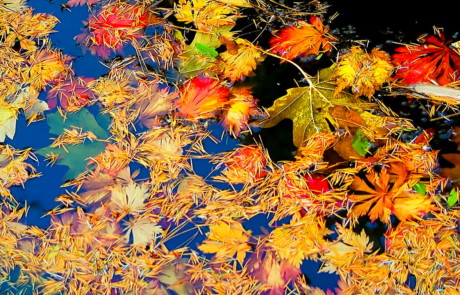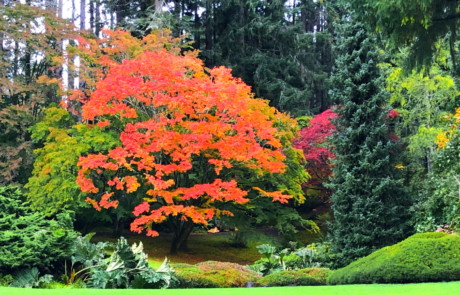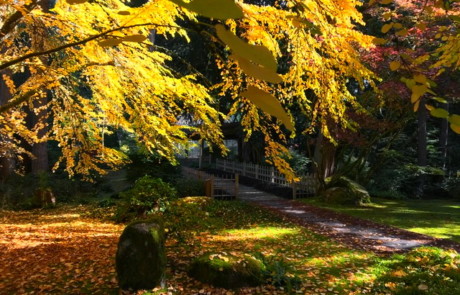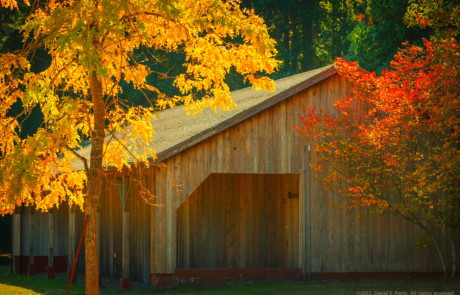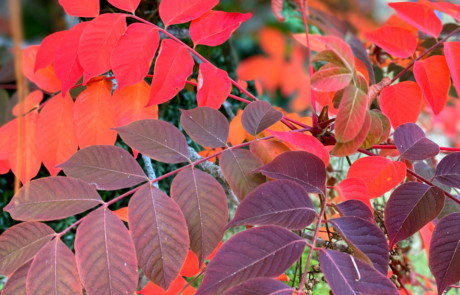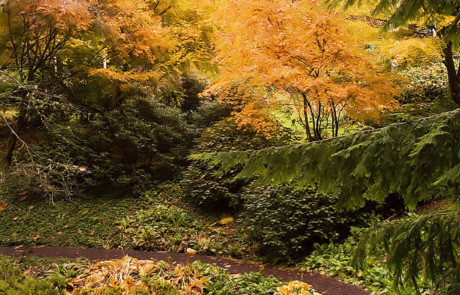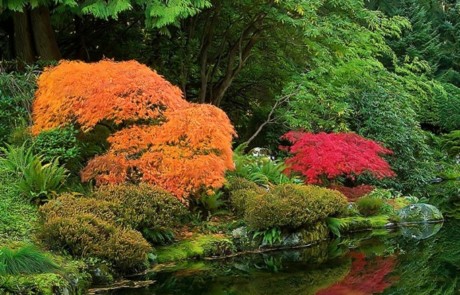The Colors of Fall
Appealing Autumn
Many people say that fall is their favorite season, citing the fragrant air, the approaching holiday season, and the changing colors of the leaves. Everyone — especially those autumn aficionados — can enjoy spectacular fall colors at Bloedel Reserve. But, did you know those brilliant fall displays are more than just pretty?
Winterizing Begins
The changing colors of the leaves hides a flurry of important biological processes. During a season when things seem to be winding down, the trees are actually actively preparing themselves for the colder days ahead. After a summer of growing and making flowers and seeds, trees have to “winterize” themselves.
Trees, like all plants, spend spring and summer converting light, water, and carbon dioxide into sugars via a process known as photosynthesis. The sugars combine with other compounds to make proteins, DNA, alkaloids, and a host of chemicals that trees need to survive and grow. Chlorophyll — the green pigment that is essential for photosynthesis as well as being responsible for giving leaves their green color — is constantly being remade because all of the summer sunshine the trees receive actually breaks down the very molecules that so efficiently capture the light.
As autumn approaches, trees detect the dropping temperatures and lengthening nights. These changes prompt trees to produce a plant hormone called abscisic acid. This hormone tells trees to begin the process of going dormant. Chlorophyll ceases to be replenished and the tree leaves gradually lose their green color.
Yellows, Reds & Golds Emerge
The leaves begin to show the underlying yellow pigments. In fact, these pigments were always there, but in the summer they are hidden by the green chlorophyll. Because the chlorophyll is disappearing as fall approaches, many leaves turn yellow, like those on the native Big Leaf Maples around the Reserve. Why, then, are some leaves orange or red in the fall?
The yellow and some orange pigments belong to a group of chemicals called carotenoids. You are already familiar with these pigments. In addition to being important for photosynthesis, these carotenoids are what give carrots and tomatoes their characteristic colors. But some shades of orange, red, purple, and blue are due to another group of plant chemicals called anthocyanins that are created as the leaves turn color. Why anthocyanins exist is not known for certain, but there are some hypotheses.
Protective Purposes Proposed
One theory about anthocyanins is that they may protect leaves against detrimental, light-related effects that occur at lower temperatures. These light effects can interfere with the transport of nutrients from leaves to other parts of the tree. Trees (as well as other plants) recycle any nutrients left in their leaves as fall comes. These nutrients are stored in the plant’s stems and roots where they can be used in the spring for new growth. Anthocyanins may help make that recycling process more efficient.
There is also some evidence that anthocyanins can be allelopathic. Allelopathy is the suppression of seedlings due to some kind of chemical effect. The chemical that suppresses seedling growth can be found deposited in the soil around the tree — a the result of leaves that have fallen and rotted. Usually the allelopathic effect does not suppress seedlings of the tree that is producing the allelopathic chemicals. In other words, if anthocyanins actually are allelopathic, they may benefit a tree’s offspring by suppressing seedlings of competing species.
Some scientists speculate that red leaf colors in the fall may reduce damage to the trees from insects and animals. These has been some research comparing trees that have red leaves in the summer to non-red-leafed varieties of the same species. The summer red-leafed trees showed a decrease in damage from aphids. It has been hypothesized, but not proven, that the red color in the fall may deter animals from eating those leaves.
A Fall Feast for the Eyes
Whatever the trees’ reasons for producing such brilliant autumn colors, we humans get the benefit of their fiery displays. At Bloedel Reserve, you will find a wide variety of colors to enjoy thanks to the many species of trees on the grounds. The leaves are usually at their colorful peak after mid-October. Be sure to check out the Japanese Garden in particular where the vibrant colors of the Japanese maples are especially eye-catching.
SIGN UP FOR OUR ENEWSLETTER
Stay up to date on all of the events and activities taking place at Bloedel Reserve.


